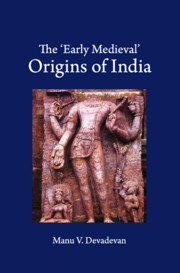Book contents
- Frontmatter
- Dedication
- Contents
- List of Tables
- List of Maps and Figures
- Acknowledgements
- 1 Introduction
- I INSTITUTIONS
- 2 State Formation and Its Structural Foundations
- 3 From the Cult of Chivalry to the Cult of Personality: The Seventh- Century Transformation in Pallava Statecraft
- 4 Changes in Land Relations and the Changing Fortunes of the Cēra State
- 5 Temple and Territory in the Puri Jagannātha Imaginaire
- II IDEAS
- 6 Svayaṃbuddha's Predilections: The Epistemologies of Time and Knowledge
- 7 Bhāravi and the Creation of a Literary Paradigm
- 8 Knowing and Being: The Semantic Universe of the Kūḍiyāṭṭaṃ Theatre
- 9 The Invention of Zero and Its Intellectual Legacy
- III IDENTITIES
- 10 The Evolution of Vernacular Languages: A Case Study of Kannada
- 11 Religious Identities in Times of Indumauḷi's Grief
- 12 Caste, Gender, and the Landed Patriarchy
- 13 The Making of Territorial Self Consciousness (with Particular Reference to Kaliṅga)
- Bibliography
- Index
3 - From the Cult of Chivalry to the Cult of Personality: The Seventh- Century Transformation in Pallava Statecraft
Published online by Cambridge University Press: 02 May 2020
- Frontmatter
- Dedication
- Contents
- List of Tables
- List of Maps and Figures
- Acknowledgements
- 1 Introduction
- I INSTITUTIONS
- 2 State Formation and Its Structural Foundations
- 3 From the Cult of Chivalry to the Cult of Personality: The Seventh- Century Transformation in Pallava Statecraft
- 4 Changes in Land Relations and the Changing Fortunes of the Cēra State
- 5 Temple and Territory in the Puri Jagannātha Imaginaire
- II IDEAS
- 6 Svayaṃbuddha's Predilections: The Epistemologies of Time and Knowledge
- 7 Bhāravi and the Creation of a Literary Paradigm
- 8 Knowing and Being: The Semantic Universe of the Kūḍiyāṭṭaṃ Theatre
- 9 The Invention of Zero and Its Intellectual Legacy
- III IDENTITIES
- 10 The Evolution of Vernacular Languages: A Case Study of Kannada
- 11 Religious Identities in Times of Indumauḷi's Grief
- 12 Caste, Gender, and the Landed Patriarchy
- 13 The Making of Territorial Self Consciousness (with Particular Reference to Kaliṅga)
- Bibliography
- Index
Summary
For much of the pre-colonial history of India, the exercise of political control had a strong element of dominance in it. Coercive means of revenue extraction was the routine form in which it was realized. Periodic display of military might and the valorization of past campaigns—both real and imagined—also contributed to the exercise of dominance. But dominance, which is control through coercion, was a limited and limiting form of engagement. It would soon fizzle out were it not played out on the safe foundations of the praxes of hegemony, which is control through consent. In the seventh century, the Pallavas of Kāñcīpuraṃ produced a model for the exercise of hegemony that turned out to be remarkably enduring and changed the imagination and practice of statecraft in the Indian subcontinent for all times to come. How this was accomplished forms an interesting chapter in the political history of India.
In the last quarter of the sixth century CE, when Siṃhavarman IV occupied the Pallava throne, his son Siṃhaviṣṇu conquered the Kāvēri delta, which was known to have been the Cōḻa heartland for several centuries. Some decades later, in the early decades of the seventh century, Siṃhaviṣṇu's son, Mahēndravarman I, inaugurated a new paradigm of statecraft that continued to prevail for nearly a century and a half, before Pallava statecraft underwent a significant transformation once again under Nandivarman II Pallavamalla. The ramifications of this shift were far-reaching and widely felt, not only in the Tamil country but across India. However, we do not have a clear understanding of the nature and implications of this shift in political praxis. Although the historiography concerning the period under examination has made considerable advances in the last four decades, there are no persuasive historical assessments of the changes that Mahēndravarman I and his successors brought into effect, and the bearings that these changes had on the larger politics and aesthetics of statecraft across large parts of the Indian subcontinent. With the exception of two remarkable theoretical propositions on the larger changes in the political economy of the period of which the seventh century was a part, the extant historiography throws little light on this question.
- Type
- Chapter
- Information
- The ‘Early Medieval' Origins of India , pp. 89 - 117Publisher: Cambridge University PressPrint publication year: 2020



